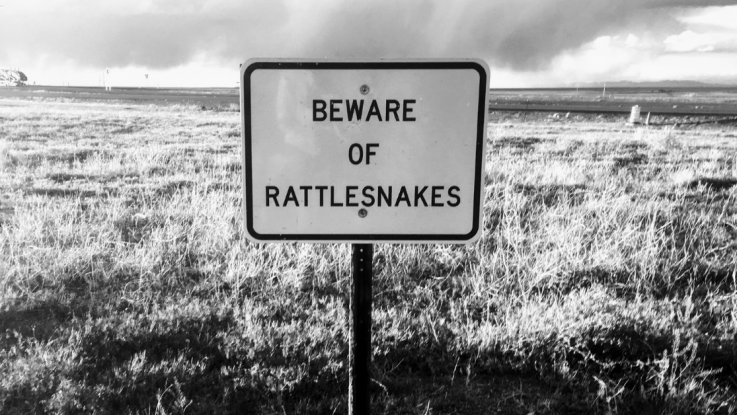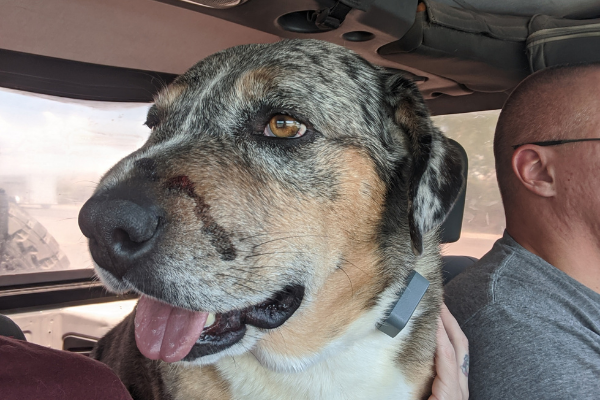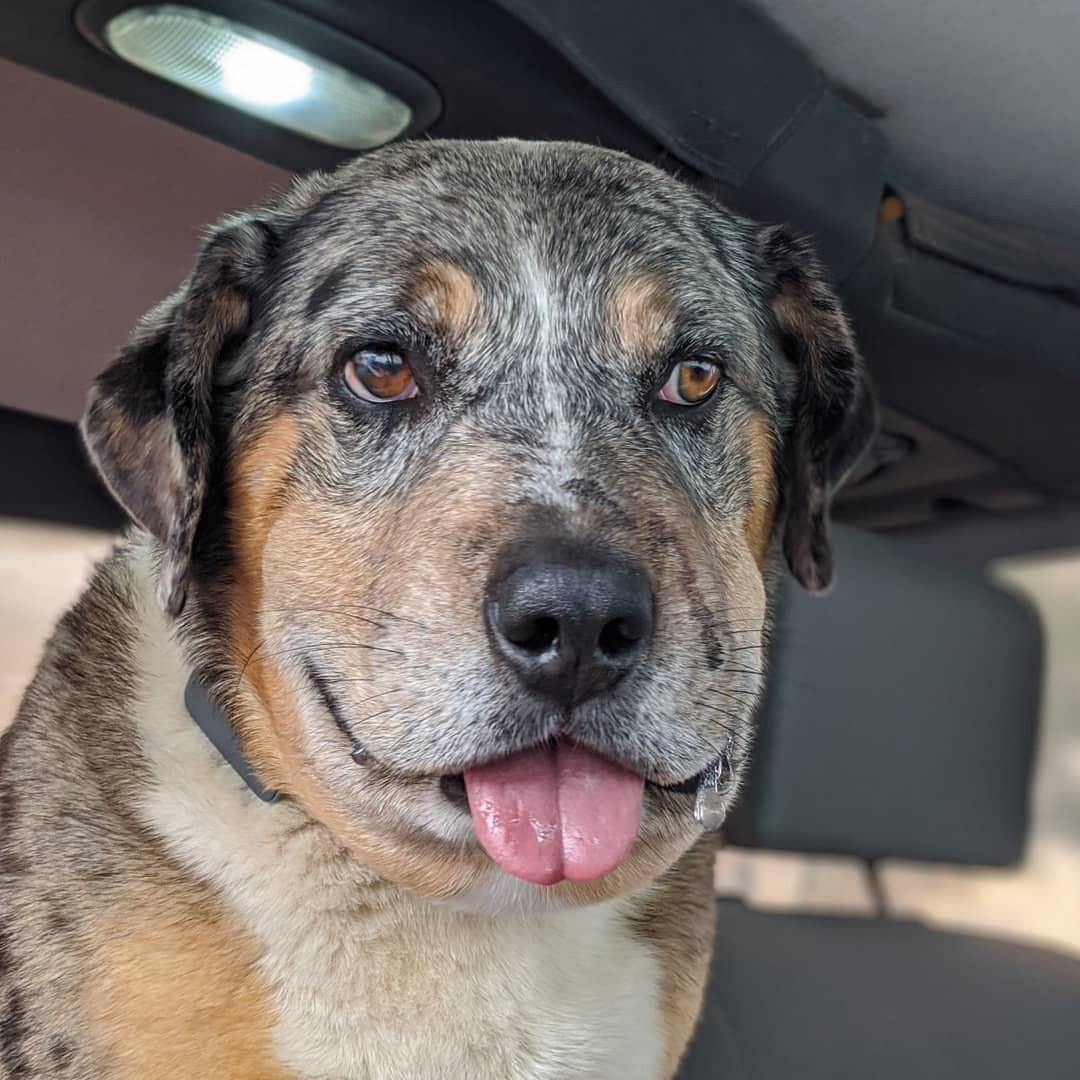
As Los Angeles and San Francisco area residents, before RV life, protecting our dogs from snakes wasn’t something we gave a lot of thought to. Before hitting the road as full-time RVers in 2017, we did some research into what our dogs may encounter in the areas where we planned to travel (the western U.S.), and rattlesnakes ended up high on our list of concerns.
We learned there was a rattlesnake “vaccine” (more on that later and why it’s in quotations), but our local northern California vet didn’t carry it. She did, however, agree that it might be something to consider when we made our way through the more rural parts of the Southwest. It took us quite a while to find a vet who stocked the rattlesnake vaccines ,but we are very happy we did. Keep reading for our tips, and the story of Lily’s worst day ever.

How severe is a rattlesnake bite
Rattlesnake bites on humans are generally not life-threatening but must be treated to avoid severe medical problems and to ensure they do not become fatal — to summarize, if you are yourself bitten, get to a hospital as soon as you can, but you’ll most likely be fine.
However, the venom’s effect is largely dictated by the size of the victim. Your dog weighs a fraction of your body weight, and the smaller the dog, the more urgent the situation is. We are no experts, but based on what we have been through, we would expect a 60-pounds dog to — at the very minimum — have life-long consequences from an untreated bite, and the recovery from a properly treated bite may take a full year. Any stories you may have heard of dogs surviving a bite without treatment are most likely from “dry bites” or mostly dry bites, with little to no venom injected.
If you encountered a Mojave Rattlesnake, you’re even worse off, since their venom also includes neurotoxins, and the “rattlesnake vaccine” mentioned here does not help at all.
So, we urge you to consider all rattlesnake bites on dogs as absolutely, 100% life-threatening. Rattlesnake venom damages blood and any tissue it comes into contact with, causes organ degeneration, and in general “turns the body into mush” — in a very literal sense — to help the snake digest its prey. The venom also causes localized pain and swelling with a wide variety of secondary effects: nausea, headaches, weakness, difficulty breathing, and so on. Even after proper treatment, the systemic effects of the bite include weakness and fatigue for a very long time.
What is the rattlesnake “vaccine” and what does it do?
There is only one product on the market currently, Crotalus Atrox Toxoid (Crotalus Atrox) = Western diamondback rattlesnake, toxoid= inactivated toxic compound used as a vaccine) from Red Rock Biologics. The vaccine helps against that specific rattlesnake subspecies and its close relatives, but not against Mojave Rattlesnake (neurotoxins), not against coral snakes (different venom), etc.
Don’t confuse this preventative vaccine with the intravenous antivenom a vet will administer after a bite. The vaccine contains inactivated venom and causes the receiving body to produce antibodies. Intravenous antivenom consists of venom antibodies, transferred from one animal to another. (A larger domestic animal is injected with small amounts of the venom in question, left to produce antibodies, and then the antibodies are extracted from its blood.) The intravenous antivenom is a life-saving treatment for a bite; the vaccine is an ahead-of-time precautionary measure that may help decrease the effects of the bite.
We are putting “vaccine” in scare quotes because it really, really is not enough to protect your dog. In the case of a bite, you still need to rush to the vet — as an after-hours emergency if needed! A delay of two hours might still be fatal. Immune system T-cell production is way too slow to protect against the effects of rattlesnake venom, and what is really needed to boost a relatively small (60 pounds) animal’s chances of survival is the intravenously injected antivenom — which costs $500-700 dollars per vial by itself, and a dog might even need multiple vials to recover.
Some doubt the effectiveness of the vaccine (see e.g. [1]). You might just be wasting money to feel good. Receiving the vaccine will not guarantee your dog’s safety if bitten, and it does not replace the need to be treated as an emergency. It simply lessens the severity of a reaction to the venom and is said to “buy you more time” to get to a vet for treatment. For a $25/year cost, that sounds good enough to us.
How to get the vaccine
The vaccine is initially given in two doses, one month apart (later boosters are just one shot). You’ll need to see the same vet for both visits, and a month can be a long time to stay in one place for an active RVer. The rattlesnake vaccine takes about one month to reach full effectiveness, so you need to get it early in the season to maximize its effect. Only vets in areas with rattlesnakes stock the vaccine, so you most likely cannot get it done before snowbird travel.
If you are traveling and don’t have a regular vet, any vet you pick will likely want to do a full checkup on your dog, and possibly bloodwork before they agree to give the vaccine — plan ahead and time it for your dog’s yearly checkup. Vets will also typically refuse to administer higher-risk vaccines on the same day as standard vaccines, so you may need extra visits to cover DHPP and rabies. You may want to call a vet ahead of time to make a plan of what gets done when.
Dogs that are not in perfect health or that tend to have adverse reactions to vaccines might not tolerate the effects of the rattlesnake vaccine at all. Smaller dogs may not be able to cope with the vaccine, leading to a dead abscess at the injection site. Our dogs are all in the 50-70-pound range and have been fine.
For areas where rattlesnakes are active throughout the year, it’s recommended to revaccinate every six months. Our home base is well below freezing in the wintertime, which means our local snakes hibernate, and we do shots every April. As noted, the vaccine takes one month to become fully effective, and it lasts about six months, which covers the heat of the summer for us.
Why we are so happy our dogs got protection
We ended our full-time RV life in September 2019. In May 2020, Lily got bit by a rattlesnake on our property in New Mexico. She was outside by herself for about 5 minutes. She came inside the house like everything was normal. About 20 minutes later she came to us, with blood running from two puncture wounds in her nose and a swollen face. We quickly popped a Benadryl down her throat, threw on our shoes, got her in the car, and sped to the vet. We were concerned because the vet was about 30 minutes away, and it had been at least 30 minutes since she was bitten. We were panicked, but we knew that this was the exact reason we had gotten our dogs the rattlesnake vaccine, so that it would buy us time to get to a vet.

On the drive, we called ahead and let them know we were coming so they were ready.

We are forever grateful to Valley Veterinary Clinic in Farmington, New Mexico. Dr. Darren Woodson whisked Lily away and got her hooked up on IV fluids and administered a vial of antivenom. Some people doubt the effectiveness of the rattlesnake vaccine, but Dr. Darren said it was good that Lily was up to date on her shot and that he did think it helped her recover. Giving Benadryl as first aid was also the right thing to do, and if you give your dog some, make sure the vet knows of it, including the dosage (otherwise, they will most likely give it too). Lily was able to come home with us the same day, after a few hours of intravenous treatments.
The final bill, with a checkup visit four days later, came to $1,251.05. That includes the one vial of rattlesnake antivenom she needed, which was $518.70.
When we got home, we looked for the snake but never found it, and haven’t seen it since.

How can you tell if a snake is venomous?
If you’re like me, you see a snake and start to do a quick-footed jumpy dance and scream, regardless of whether you know the snake is venomous. It is good to know how to identify a “good guy” from a “bad guy.”.
The easiest thing to remember is that venomous snakes generally have broad, triangular heads. Whereas nonvenomous snakes tend to have a more rounded head. Rattlesnakes, and vipers in general, tend to have a pretty distinctive pattern on their back, but unfortunately, mimicry is a good survival strategy, and harmless gopher snakes have similar patterns. Outside the American Southwest, you need to learn whatever your local snakes are.
Rattlesnakes are, of course, famous for the rattle in their tail. If you see or hear it, you can be pretty sure you’re dealing with the real thing. If you see a snake coiling up defensively, you’re also likely dealing with the real thing. If you get a good look at the tail of something that looks like a rattlesnake, and the tail just slims down to a tip with nothing special about it, and it’s not a tiny baby snake, you’re most likely looking at a gopher snake, who just wants to be left alone, is doing his best to keep the rodent population down, and will generally try to avoid you. Gopher snakes also tend to not coil up when afraid; instead, we’ve seen them either try to move away or “play dead.”
We have come across many young rattlesnakes, which can be harder to identify because their rattle isn’t fully developed yet. However, even on a young rattlesnake, you’ll generally see the tip of the tail having a different color or shape. Young rattlesnakes have less venom by volume, and in general, their bites are less serious. However, their venom has more neurotoxins, so you should still take the bites of young rattlesnake seriously.

Other ways to protect your dog from snakes
Avoiding a venomous snake is —obviously — much better than hoping for a quick recovery. Here’s what you can do:
* Teach your dog simple commands such as “come” and “leave it!” so you can control them if you see a snake.
* When on a hike, make sure to scan the trail ahead of you, so you see the snake before your dog does.
* Avoid reaching under bushes and rocks where you can’t see, and keep your dog away from them, too. In mid-day heat, snakes will prefer staying in the shade.
* Keep your dog on leash if they’re not great with voice commands.
* Keep the area around your RV free of food that could attract rodents, as snakes hunt rodents. Remove any clutter where a snake could hide.
* When arriving at a new location, find the phone number to the local emergency vet (preferably one with 24-hour service). You may also want to call and ask if they stock antivenom.
* Consider rattlesnake aversion training. This training teaches your dog to avoid the sight, smell, and sound of rattlesnakes. This is usually done by a trainer with a contained live rattlesnake, and when your dog approaches, it is delivered a painful shock via e-collar. There are some trainers who do not use the pain-based approach, but they are harder to find. We have not done any official training yet, but when we encounter dead snakes (usually that have been run over on our road), we use it as an opportunity to do some training on our own. With the dog on leash, walk toward the snake and then firmly say “leave it!” and walk a wide path around the snake, and then reward them for doing so. Lily is, of course, a star pupil at this, remembers where the dead snake is, and gives it a wide detour. It’s our hope that the dog will associate the smell of the snake as something to avoid, just like they know not to go near a mouse caught by a trap.
* And just in case someone does get bitten, add Benadryl to your hiking bag, and know the proper dosage for your dog.
How Lily is doing today?
Overall Lily is doing great, but she does have some lasting effects from her rattlesnake encounter. She has suffered decreased energy, scarring at the bite site, and residual swelling/fluid in her neck. She’s had regular vet checkups since, and her bloodwork is great and shows nothing to be concerned about. Her energy levels started improving only a full year after the bite, and she’s still not quite to her previous self.
We hope this article was educational and prevents others from going through what Lily went through. If you live in an area of the United States where the temperature dips below freezing during winter, snakes will be coming out of hibernation soon, so now is a good time to discuss with your vet what’s best for your dog. Please do your due diligence, as this is post is only our personal experience.
Has your dog had a rattlesnake encounter? Have you done rattlesnake aversion training? Share your experience below in the comments!
| Ane and Tommi, F462447, of The Dog Is Driving love how RVing allows them to go on adventures with their rescue dogs: Delta, Mushy, and Lily Goodgirl. They were full-time RVers for nearly three years before transitioning to part-time RVing. Read their experiences and campsite reviews through a pet-friendly lens on Instagram and TheDogisDriving.com. |


Great read. Thank you. Rattlesnakes really bug me, many of them around here in Eastern WA.
Thank you, Barbara!